

Trump and the Revolt of the Rust Belt. Much has been made of the inaccuracy of exit polls and voting projections amidst Trump’s shocking win this week.
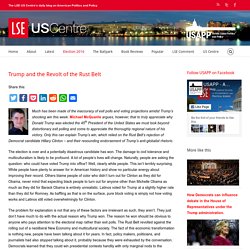
Michael McQuarrie argues, however, that to truly appreciate why Donald Trump was elected the 45th President of the United States we must look beyond distortionary exit polling and come to appreciate the thoroughly regional nature of his victory. Only this can explain Trump’s win, which relied on the Rust Belt’s rejection of Democrat candidate Hillary Clinton – and their resounding endorsement of Trump’s anti-globalist rhetoric.
The election is over and a potentially disastrous candidate has won. The damage to civil tolerance and multiculturalism is likely to be profound. A lot of people’s lives will change. The problem for explanation is not that any of these factors are irrelevant as such, they aren’t. Trump had a losing hand against the Obama coalition. The Rust Belt states that delivered the presidency to Trump—Pennsylvania, Wisconsin, and Michigan—were extremely close. How age, race and gender are deciding factors in the US presidential election.
Trump’s foreign policy speech was an attempt to woo independent voters for the general election, not placate foreign leaders. Yesterday, Donald Trump followed his victory in the ‘Acela Primary’ with a major speech on foreign policy.
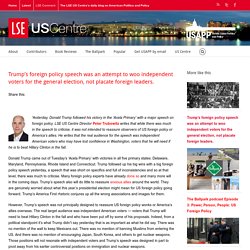
LSE US Centre Director Peter Trubowitz writes that while there was much in the speech to criticise, it was not intended to reassure observers of US foreign policy or America’s allies. He writes that the real audience for the speech was independent American voters who may have lost confidence in Washington, voters that he will need if he is to beat Hillary Clinton in the fall. Donald Trump came out of Tuesday’s ‘Acela Primary’ with victories in all five primary states: Delaware, Maryland, Pennsylvania, Rhode Island and Connecticut. Trump followed up his big wins with a big foreign policy speech yesterday, a speech that was short on specifics and full of inconsistencies and so at that level, there was much to criticise. Many foreign policy experts have already done so and many more will in the coming days. Featured image America First rally, 1940. Shortened URL for this post:
More than 80% of Trump supporters see refugees as threat to US, survey shows. More than eight in 10 Republicans who support Donald Trump regard refugees from Iraq and Syria as a major threat to the US, according to a survey that lays bare the deep political polarisation in America.
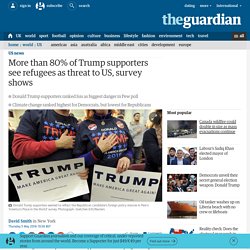
Trump’s creed of “America first” set out in a recent foreign policy speech in Washington appears to be resonating with Republicans who believe the US should put its own interests ahead of playing the role of global policeman. “America’s Place in the World” is a survey of foreign policy attitudes conducted periodically by the Pew Research Center. The latest poll was carried out among 2,008 US adults from 12 to 19 April, before Ted Cruz and John Kasich pulled out of the race for the Republican nomination. For those who back the New York billionaire in the primary campaign, the large number of refugees fleeing the conflict in Iraq and Syria is especially worrisome, according to Pew.
But the survey found the widest gap by far in perception of global dangers to the US is over climate change.
How Both Parties Lost the White Middle Class. Religion. Race. Age. A Deep Dive Into Party Affiliation. Sharp Differences by Race, Gender, Generation, Education Survey Report Democrats hold advantages in party identification among blacks, Asians, Hispanics, well-educated adults and Millennials.
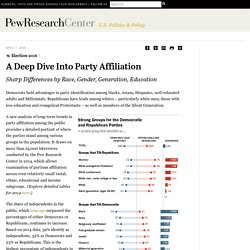
Republicans have leads among whites – particularly white men, those with less education and evangelical Protestants – as well as members of the Silent Generation. A new analysis of long-term trends in party affiliation among the public provides a detailed portrait of where the parties stand among various groups in the population.
It draws on more than 25,000 interviews conducted by the Pew Research Center in 2014, which allows examination of partisan affiliation across even relatively small racial, ethnic, educational and income subgroups. The share of independents in the public, which long ago surpassed the percentages of either Democrats or Republicans, continues to increase. A closer look at … Race and ethnicity. Gender. Education. Generations. Religion. Party Affiliation 1992-2014. Trends in Party Identification, 1939-2014. For more than 70 years, with few exceptions, more Americans have identified as Democrats than Republicans.
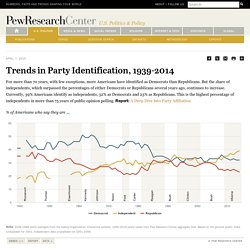
But the share of independents, which surpassed the percentages of either Democrats or Republicans several years ago, continues to increase. Currently, 39% Americans identify as independents, 32% as Democrats and 23% as Republicans. This is the highest percentage of independents in more than 75 years of public opinion polling. Report: A Deep Dive Into Party Affiliation % of Americans who say they are ...
Note: 1939-1989 yearly averages from the Gallup Organization interactive website. 1990-2014 yearly totals from Pew Research Center aggregate files. Embed this Graphic: